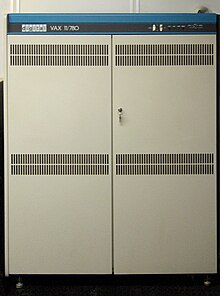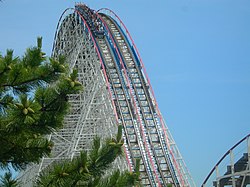Superminicomputer
Superminicomputer슈퍼미니컴퓨터는 보통 슈퍼미니컴퓨터로 표현하면 슈퍼미니컴퓨터는 [1]하이엔드 미니컴퓨터였다.이 용어는 1970년대 중후반에 도입된 새로운 32비트 아키텍처 미드레인지 컴퓨터와 이전의 [2][3]기존 16비트 시스템을 구별하기 위해 사용되었습니다.이러한 컴퓨터의 개발은 대용량 메모리를 [1]다루는 애플리케이션의 필요성에 의해 추진되었습니다.midicuputer라는 용어는 이전에 [4][5]이러한 시스템을 가리키는 데 사용되었습니다.가상 메모리는 종종 [6]이 클래스의 시스템에 포함시키기 위한 추가 기준이었습니다.이 기계들의 연산 속도는 16비트 미니 컴퓨터보다 훨씬 더 빨랐고 소형 메인프레임 [7]컴퓨터의 성능에 근접했습니다.이 이름은 특정 정의가 결여된 "마케터"에 의해 만들어진 "금권적" 용어로 설명되는 경우가 있습니다.시스템의 종류를 설명하는 것은 역사적으로 문제가 있는 것으로 여겨져 왔다: "컴퓨터 왕국에서 장비의 분류학적 분류는 [8]과학이라기보다는 검은 예술에 가깝다."어떤 시스템이 이 클래스에 포함되어야 하는지에 대해 약간의 의견 차이가 있습니다.그 이름의 유래는 확실하지 않다.[1]
테크놀로지가 급속히 발전함에 따라 미니컴퓨터와 슈퍼미니컴퓨터의 퍼포먼스가 [9]모호해졌다.메인프레임 컴퓨터를 판매한 기업들은 슈퍼미니컴퓨터와 [10]동일한 가격과 성능 범위의 기계를 제공하기 시작했습니다.1980년대 중반까지 초소형 컴퓨터의 하드웨어 아키텍처를 갖춘 마이크로프로세서는 과학 및 엔지니어링 워크스테이션을 [11]생산하기 위해 사용되었습니다.그 후 미니컴퓨터 [12]산업은 1990년대 초반까지 쇠퇴했다.이 용어는 이제 구식으로[13] 여겨지지만 컴퓨터 역사의 학생/연구자들에게는 여전히 관심사로 남아 있습니다.
주목받는 기업
1980년 초소형 컴퓨터 제조업체는 다음과 같습니다.Digital Equipment Corporation, Perkin-Elmer 및 Prime Computer.[14][15]다른 시스템 제조업체로는 SEL/Gould 및 Data General이 있습니다.[16]4년 후, 상당한 수의 초소형 컴퓨터를 [17]생산하는 회사가 약 12개 있었다.

| 회사 | 퍼센트 |
|---|---|
| International Business Machine(International Business Machine) | 41.9 |
| 디지털 이그니션 코퍼레이션(DEC) | 27.6 |
| 데이터 일반 | 6.0 |
| 프라임 컴퓨터 | 5.6 |
| Perkin-Elmer(이전의 Interdata) | 3.4 |
| 왕 연구소 | 3.4 |
| Gould(구 SEL) | 2.6 |
| 휴렛패커드 | 2.2 |
| 허니웰 | 2.2 |
| Harris 컴퓨터 시스템즈 | 1.7 |
| (기타) | 3.4 |
Perkin-Elmer는 1985년에 Data Systems Group을 분사하여 Concurrent Computer Corporation을 설립하여 이러한 시스템을 계속 만들었습니다.닉스도르프 컴퓨터, 노르스크 데이터, 도시바 등도 시스템을 [10]생산했다.
중요한 슈퍼미니컴퓨터
- Interdata 7/32, 1974년[3]
- Digital Equipment Corporation VAX-11/780, 1978[19][A]
- 프라임 컴퓨터 750, 1979년[20]
- Data General Eclipse MV/8000, 1980[21][B]
- IBM 4361, 1983[24]
- IBM 9370, 1987[12]
외부 링크
 Wiktion에서 슈퍼미니컴퓨터의 사전 정의
Wiktion에서 슈퍼미니컴퓨터의 사전 정의
레퍼런스
- ^ a b c Connolly, James (September 30, 1985). "Superminis: Dynamic machines evolving to new uses". Computerworld. p. SR/4, SR10. Retrieved 5 December 2019.
No one can say with certainty who coined the word 'superminicomputer' and to what systems he meant it to apply, but consensus is emerging that a supermini is nothing more than a minicomputer — a high-end mini, but a mini nonetheless.
- ^ Flowers, Jeff (1982). "The Use of the 32-Bit Minicomputer for Data Acquisition". IEEE Transactions on Nuclear Science. 29 (1): 927–931. Bibcode:1982ITNS...29..927F. doi:10.1109/TNS.1982.4335992. S2CID 28156759.
- ^ a b Supnik, Bob (July–August 2004). "Simulators: Virtual Machines of the Past (and Future)". Queue. ACM. 2 (5): 52–58. doi:10.1145/1016998.1017002.
Thirty-two-bit computing broke out of the mainframe category with the introduction of the 'supermini' Interdata 7/32 in the mid-1970s and then the VAX in 1977.
- ^ Yates, Edward H. (August 1980). Interrelationships of Technology, System Performance, and Prices for Mini/Midicomputers (PDF) (Report). Office of the Secretary of the Army. p. 3. Archived (PDF) from the original on December 14, 2019. Retrieved 14 December 2019.
- ^ Burr, William E.; Gordon, Robert (October 1977). "Selecting a Military Computer Architecture". Computer. Vol. 10, no. 10. IEEE. pp. 16–23. doi:10.1109/C-M.1977.217522.
- ^ Storassli, Olaf O.; Vidal, James B.; Jones, Gary K. (1982). "An evaluation of superminicomputers for thermal analysis" (PDF). Computational Aspects of Heat Transfer in Structures. NASA technical memorandum. Washington, DC: NASA (83284): 2. Bibcode:1982caht.nasa..437S.
- ^ a b Wallich, Paul (1985). "Minis and mainframes: Superminicomputers push mainframe performance, mainframes operate at supercomputer speeds, and supercomputers reach 400 million operations per second". IEEE Spectrum. 22: 42–44. doi:10.1109/MSPEC.1985.6370525. S2CID 27187801.
The manufacturers of the new processors all measure their machines against the venerable Digital Equipment Corp. VAX 11/780, which performs somewhat more than a million operations per second.
- ^ Stiefel, Malcolm L. (July 1978). "Superminis: What's In The Name?". Mini-Micro Systems. Vol. 11, no. 7. pp. 29–42.
At first blush, the word 'supermini' seems to be a contradiction in terms, like 'bittersweet.' There is a temptation to dismiss it immediately as a frivolous pun - the fruit a fertile Mad Ave. mind. In a sense, this gut reaction has merit; the term was obviously coined by marketeers to describe succinctly a class of machines without being too specific.
- ^ Vardalas, John N. (2001-07-27). The Computer Revolution in Canada: Building National Technological Competence. ISBN 9780262264983.
As circuit densities and performance increased and prices dropped, the demarcation between minicomputers and superminicomputers and that between low and middle ranges of mainframes began to blur.
- ^ a b Supercomputers. Oxford: Elsevier. 1991. p. 3. ISBN 9781483296197.
- ^ Joy, W.; Gage, J. (1985). "Workstations in Science". Science. 228 (4698): 467–470. Bibcode:1985Sci...228..467J. doi:10.1126/science.228.4698.467. PMID 17746877. S2CID 9058777.
- ^ a b Bell, Gordon (2014). "STARS: Rise and Fall of Minicomputers". Proceedings of the IEEE. 102 (4): 629–638. doi:10.1109/JPROC.2014.2306257. S2CID 21352766.
- ^ "superminicomputer". Oxford English Dictionary. Oxford University Press. June 2012. 268008.
Now historical.
- ^ Steinberg, Michael A. (1979). "Promoting computer literacy". Proceedings of the 7th annual ACM SIGUCCS conference on User services - SIGUCCS '79. p. 83. doi:10.1145/601889.601932. ISBN 0897910060. S2CID 17187367.
- ^ Rosenberg, Ronald (30 Apr 1980). "Unveiling a 'supermini'". Boston Globe.
- ^ "HP to enter supermini stakes?". Electronics & Power. August 1981. ISSN 2053-7883. Retrieved 5 December 2019.
- ^ a b Davis, Bob (22 Jan 1985). "Prime Computer's New Model Heats Up Race To Construct the Fastest Superminicomputer". Wall Street Journal.
- ^ a b Zorpette, Glenn (1985). "The beauty of 32 bits: This near-optimum bit width has unprecedented potential for the well-informed designer of microprocessor-based systems". IEEE Spectrum. 22 (9): 65–71. doi:10.1109/MSPEC.1985.6370815. S2CID 34626939.
- ^ Rosenberg, Ronald (3 Mar 1983). "...'we never look over our shoulder' — Digital". Boston Globe.
- ^ "Firm's Sales on Rebound Thanks to Supermini". Computerworld. Jul 27, 1981.
- ^ Rosenberg, Ronald (2 Nov 1985). "Data General does it with class". Boston Globe.
- ^ Borins, Sandford; Herst, Beth (2018). "Insanely Great: The Dominant IT Fable". Negotiating Business Narratives. pp. 13–22. doi:10.1007/978-3-319-77923-2_2. ISBN 978-3-319-77922-5.
- ^ Kidder, Tracy (1981). "The Microkids and the Hardy Boys: An inside look at how a maverick team from Data General 'rescued' the company by designing a competitive 32-bit superminicomputer in record time". IEEE Spectrum. 18 (9): 48–55. doi:10.1109/MSPEC.1981.6369813. S2CID 5650132.
- ^ Rosenberg, Ronald (16 Sep 1983). "2 mid-sized computers are introduced by IBM". Boston Globe.
'They even called the new 4361 a multi-application superminicomputer, a term they never used before.'



